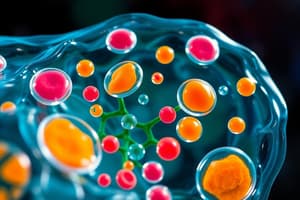Podcast
Questions and Answers
What did Robert Hooke refer to when he coined the term 'cell'?
What did Robert Hooke refer to when he coined the term 'cell'?
- The biological processes in living organisms
- Small empty chambers in plant tissue (correct)
- The basic unit of matter
- The structure of organic compounds
Which scientist contributed to the foundational concepts of cell theory alongside Matthias Schleiden?
Which scientist contributed to the foundational concepts of cell theory alongside Matthias Schleiden?
- Theodor Schwann (correct)
- Charles Darwin
- Gregor Mendel
- Louis Pasteur
In the context of the molecular composition of a cell, which of the following is considered an inorganic molecule?
In the context of the molecular composition of a cell, which of the following is considered an inorganic molecule?
- Fatty acids
- Amino acids
- Glucose
- Water (correct)
Which structure within the cell is primarily responsible for protecting genetic material?
Which structure within the cell is primarily responsible for protecting genetic material?
What is the primary role of the nucleolus within the nucleus of a cell?
What is the primary role of the nucleolus within the nucleus of a cell?
What is a key structural component found in the cell membranes of all listed organisms?
What is a key structural component found in the cell membranes of all listed organisms?
Which biomolecule is categorized as a carbohydrate based on its general formula?
Which biomolecule is categorized as a carbohydrate based on its general formula?
Which of the following is a characteristic unique to prions compared to other pathogens?
Which of the following is a characteristic unique to prions compared to other pathogens?
In comparison to plant cells, which component is typically absent in animal cells?
In comparison to plant cells, which component is typically absent in animal cells?
Which pathway is most directly associated with cell membrane fluidity and consistency?
Which pathway is most directly associated with cell membrane fluidity and consistency?
Flashcards are hidden until you start studying
Study Notes
Cell Membrane
- Composed of phospholipid bilayer, glycoproteins, glycolipids, and cholesterol.
- Glycoproteins and glycolipids play a key role in cell recognition and signaling.
- Cholesterol maintains membrane fluidity and stability.
- Arachidonic acid is involved in the eicosanoid pathway, crucial for signaling.
Organisms with Cell Membranes
- Present in various organisms: plants, bacteria, fungi, and animals.
- Animals have additional structural components like exoskeletons in arthropods (lobsters and crabs).
Cytoplasm
- Cytoplasm contains nutrients and by-products, providing a medium for cellular processes.
- Includes inclusions and organelles suspended in cytosol, a semi-transparent fluid.
Organelles
- Organelles are small structures within the cytoplasm that perform specific functions essential for cell survival.
Cell Division
- Process involves mitosis and cytokinesis.
- Mitosis occurs after the interphase of the cell cycle, ensuring accurate division of genetic material.
Prions
- Infectious agents that cause neurodegenerative diseases like bovine spongiform encephalopathy (BSE) in cattle, scrapie in sheep, and Creutzfeldt-Jakob disease (CJD) in humans.
Plant Cell vs Animal Cell
- Distinct structures characterize plant and animal cells, notably differences in cell wall, chloroplasts, and vacuoles.
Biomolecules
- Four main categories: carbohydrates (CnH2nOn), lipids (fats & waxes), proteins (CHON), and nucleic acids (CHONP).
Biochemistry Overview
- Focuses on the chemical basis for living systems, including reactions and processes underlying biological functions.
Historical Notes
- Robert Hooke first identified cells, naming them after the monk's cells due to their box-like appearance in cork.
- Matthias Schleiden and Theodor Schwann established that all plant and animal tissues are composed of cells, laying foundational concepts for cell theory.
Cell Structure
- Composed of water, organic molecules, and inorganic molecules.
- Key components include the nucleus, cytoplasm, and cell membrane.
Nucleus
- Encased by a nuclear membrane that protects genetic material and contains nucleoli for ribosomal assembly.
- Nucleoplasm serves as the matrix for chromatin and nucleoli.
Prokaryote vs. Eukaryote
- Prokaryotes lack a true nucleus and membrane-bound organelles; DNA is circular.
- Eukaryotes have a true nucleus and various organelles; DNA is linear.
- Exception includes Borrelia burgdorferi, which has a linear chromosome despite being prokaryotic.
Chromatin and Chromosomes
- Chromatin exists in threadlike (euchromatin) and rod-like (chromosomes) forms; transcription occurs during euchromatin states.
- Histones are proteins that help package DNA, forming nucleosomes which affect gene expression through epigenetic marks.
Studying That Suits You
Use AI to generate personalized quizzes and flashcards to suit your learning preferences.




